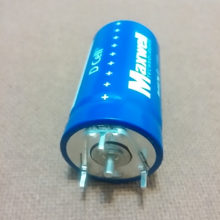Description
Working Voltage: 2.7 V
Surge (Maximum) Voltage: 2.85 V (Non-Repeated. Not to exceed 1 second)
Absolute Maximum Current: 27 A
Typical Short Circuit Current: 140 A
Capacitance: 50 F
Operating Temperature Range: -40oF to 149oF
Storage Temperature Range (Uncharged): -40oF to 158oF
Maximum ESR (at 25oC): 0.042 Ohms (42 mOhm)
Termination Style: Radial
Terminals: Wire Leads
Case Length: 40 mm (1.57 inches)
Case Diameter: 18 mm (0.71 inches)
Positive Terminal Lead Length: 29mm (1.125 inches )
Negative Terminal Lead Length: 22mm (0.875 inches)
Lead Diameter: 0.8mm (0.031 inches)
Lead Spacing: 7.5mm (0.30 inches)
Weight: 13 g (0.46 ounces)
NB: ESR stands for Equivalent Series Resistance.
SAFETY:
1) Do not reverse polarity. The smaller lead is the negative terminal. There is a minus (–) sign on the side of negative terminal. Always make sure your power supply is connected properly to the capacitor. Failure to do so may result in the damage of the capacitor.
2) Do not exceed the rated voltage of the capacitor.
3) Do not exceed the maximum current of the capacitor.
4) Always look at the current rating of your power supply and make sure you don’t exceed it, because a capacitor (without an external resistor connected to it in series) behaves like a short circuit at initial charge.
FEATURES AND BENEFITS
- Up to 500,000 duty cycles or 10 Year Life.
- Ultra Low ESR/Low Internal Resistance for high power density.
- Large Capacitance for High Energy Density.
- Large operating temperature range.
- Constructed with high performance materials.
- Cell voltage determined by the circuit application, not limited by the cell chemistry.
- High power available.
- High power density.
- Simple charging methods. No special charging or voltage detection circuits required.
- Very fast charge and discharge. Can be charged and discharged in seconds. Much faster than batteries.
- No chemical actions.
- Cannot be overcharged.
TYPICAL APPLICATIONS
- Backup Power.
- Smart Meters.
- Consumer and Industrial Electronics.
- Wireless Transmitters.
- High shock and vibration environments.
- Automotive subsystems.
- Wind turbine pitch control.
- Hybrid vehicles.
- Rail.
- Heavy industrial equipment.
- UPS & telecom systems.
- Back-Up Power.
- Regenerative Power.
- Burst Power.
- Quick Charge.
- Cold Starting.






Reviews
There are no reviews yet.